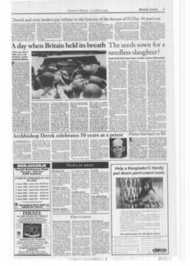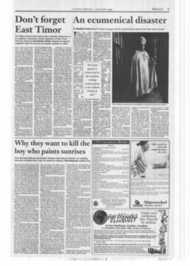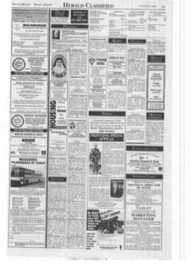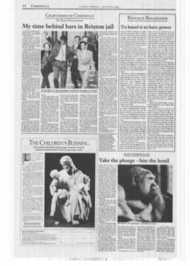Page 5, 10th June 1994
Page 5

Report an error
Noticed an error on this page?If you've noticed an error in this article please click here to report it.
Tags
Share
Related articles
Ten Years On Death Row
Death Row
Death Row Splits Us And Pope
News In Brief
English Bishops Send Prayers For Dead And Pleas For Peace
Why they want to kill the boy who paints sunrises
Even the Pope believes that Catholic Mexican artist Manuel Salazar, now awaiting execution on Death Row in the US, should be released. Paul Donovan explains why.
WFIEsi POPE JOHN Paul visited the United States last year he was presented by Cuco Chevez, the famed liturgical singer and composer, with a painting called the Rising Sun. The painting was the work of a young Catholic artist named Manuel Salazar. Manuel's paintings have been displayed across the United States and have attracted much acclaim. As an artist Manuel Salazar is unique he works from a cell at Pontiac Correctional Centre in Illinois. He is one of what American organisation Death Watch estimate to be 200 innocent individuals awaiting execution on Death Row. Whilst in the US the Holy Father interceded for Manuel Salazar with Governor Jim Edgar of Illinois. The Pontiff requested the release or return of Manuel Salazar to Mexico. To date, John Paul H's request, and those of c-ountless others remain unanswered.
In Britain MP Jeremy Corbyn has put down two Early Day Motions in the House of Commons. The most recent EDM was signed by 116 MP's. Judy Ward and Gerry Hunter of the Birmingham Six both campaigned for Salazar in Britain. Judy Ward said: "I was told many times that if the death penalty had been in force in 1974, I would have been executed."
Manuel Salazar was born to Mexican parents in Joliet, Illinois on 20 February, 1966. He has been in prison since the age of nineteen. Under US law Manuel Salazar is an American citizen, because he was born in the United States. According to the Mexican Constitution he is a Mexican citizen because his parents are Mexican nationals.
On 12 September 1984, Manuel Salazar and some friends were riding in a car in his home town of Joliet. The car was stopped by the police because there were black and Latino people inside, a cause for suspicion in Joliet. Manuel did have a gun possession charge and had been target shooting down by the river earlier that day. The gun was unregistered, Manuel panicked and ran from the car. Police Officer Martin Murrin drew his gun and gave chase. Manuel Salazar threw his bag over a fence but got himself trapped against the fence by the policeman. Murrin put his gun away and proceeded to hold his prisoner down and repeatedly punch him in the face. Struggling to escape, Manuel managed to wriggle free. The officer drew his gun and threatened to kill Manuel Salazar. In the ensuing struggle the gun went off whilst in the Officer's hand (gunpowder marks on Murrin's hands verify this) killing him. Manuel escaped to Mexico where, according to family, upon arrival he was unrecognisable due to the physical beating he had received. His vision remained blurred for some time after the incident.
Rather than seek extradition via the usual channels the US authorities decided to abuse Mexican sovereignty and support a cross border kidnap operation. In May 1985 paid agents made a raid on the family home and took Manuel Salazar back to America. According to a report from the Nuevo Leon State Office on Human Rights the US, police paid 85000 for the kidnap operation.
Racism clearly permeates this case. Joliet has a large Mexican population, who are familiar with police harassment. The town is divided by a river. The white population live on the West side and the Mexican and Black population on the East. Manuel was tried and found guilty by an all white jury. An appeal to the Illinois Supreme Court was rejected though there were two strong dissenting judgements. Justices Clark and Stamos concurred in saying, "The death of a police officer evolves strong feelings among members of the law enforcement community, judges concluded. Any tendency to bend the rules in favour of conviction, however can and must be resisted." The US Supreme Court refused to hear the case.
The case returned to the Circuit where a question raised concerning the lack of a petition for extradition from Mexico, prior to the kidnap, was ignored. 27 March 1993 was set as the execution date. This was stayed on an appeal, concerning the Circuit Judge Ewart's ruling, to the Illinois Supreme Court.
Judge Ewart had heard a number of grounds for a retrial but denied all of them. Among the most striking of these was that the counsel defending Manuel Salazar had, prior to the trial, been charged with bribing a policeman. Whilst on Death Row Manuel received a latter saying that the attorney had been suspended from the practice of law. In addition the attorney had been defending another Joliet officer at the same time that he was representing Manuel Salazar giving rise to a possible conflict of interest.
Judge Ewart also chose to ignore a sworn affidavit concerning the condition of Manuel Salazar when he reached Mexico. A doctor and two other witnesses who could have testified as to his physical conchtion were not called.
Much of the police story appears suspect. Statements have disappeared. One testimony that was vital to the prosecution case appears to have been manufactured. The individual has since come forward and testified as to how the police had tried to confuse him and extract falsified statements. He described how the tape recording machine was turned on and off until the police obtained the recording they required.
Communication of police activities on September 12 1984 were supposed to be recorded but due to a malfunction in the equipment this data was lost.
Delivering judgement Justice Ewart decreed that proof of the value of Salazar's life was inadequate.
An international campaign has daily gathered strength. Among those supporting the case in the US are Cardinal Bffnardin, the Justice and Peace Commission of Los Angeles, Amnesty International, Ramsey Clark: former US Attorney General, the National Black Police Association, Coalition Pro Justice and Milton Grimes (attorney for Rodney King). The International Secretariat of Amnesty International in London has written to Governor Edgar expressing concern about the case and particularly the illegal abduction of Manuel Salazar from Mexican soil. The Maryknoll order in Mexico and 90 members of the House of Deputies of the Mexican Congress have expressed their support. The campaign is also gaining international support from Latin America and Europe.
Commenting on the case Jeremy Corbyn said: "Manuel is one of a long list of people facing the death penalty in the USA. He is innocent and should be released. No country can claim to be civilised whilst it includes murder in its legal apparatus." On January 12 1994 Gerry Hunter of the Birmingham Six attended as an international observer the most recent hearing of the Illinois Supreme Court. The court will decide in the next few months whether Manuel Salazar will be re-tried or executed.
For further details of the case please contact: Manuel Salazar Campaign, do Room 8, 219 Mare Street, London E8 3QQ
blog comments powered by Disqus













